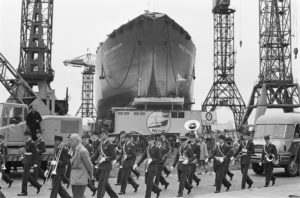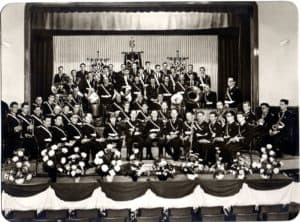 Collaboration with NDSM The first launch at the NDSM to which HCT cooperated was in 1947 and concerned the motor vessel ‘Bougainville’. The members who did not work at the NDSM could not work because they paid the wages that they paid from the NDSM. After every launching, people were welcomed to drink and cigars. In the 1950s, HCT granted its support to around seven launches per year; in the beginning of the sixties this went down to three or four per year. The launch of the ‘Vasum’ in 1955 by Princess Beatrix can still be remembered by many, because many photographs were made that were popular among the members. The financial support of the NDSM was indispensable in those years. For the purchase of instruments in 1951, the NDSM had advanced an amount of 10,000 guilders interest-free. The repayment of this debt was a constant concern for the treasurer, but without the NDSM the investment in instruments could not even have taken place. This was even stronger for the maintenance of the uniforms and for the purchase of uniforms for new members. “The registration of a new member for the association means an investment of almost 1000 guilders (an instrument of 500 to 600 guilders and a uniform of about 300 guilders) is a fact that people usually do not realize,” wrote the then chairman A.J. ten Nijenhuis in the Gedenkboekje on the occasion of the 40th anniversary in 1962. In 1957 NDSM director De Boer retired. The new patron of HCT then became his successor A.A. van Donkelaar. From 1959 the association received an additional amount of 150 guilders for each launch. On 15 December 1961, HCT was of course also present when the 100th ship built by the NDSM after the war was launched: the Esso Lincoln. In total, HCT would also cooperate with more than a hundred launches.
Collaboration with NDSM The first launch at the NDSM to which HCT cooperated was in 1947 and concerned the motor vessel ‘Bougainville’. The members who did not work at the NDSM could not work because they paid the wages that they paid from the NDSM. After every launching, people were welcomed to drink and cigars. In the 1950s, HCT granted its support to around seven launches per year; in the beginning of the sixties this went down to three or four per year. The launch of the ‘Vasum’ in 1955 by Princess Beatrix can still be remembered by many, because many photographs were made that were popular among the members. The financial support of the NDSM was indispensable in those years. For the purchase of instruments in 1951, the NDSM had advanced an amount of 10,000 guilders interest-free. The repayment of this debt was a constant concern for the treasurer, but without the NDSM the investment in instruments could not even have taken place. This was even stronger for the maintenance of the uniforms and for the purchase of uniforms for new members. “The registration of a new member for the association means an investment of almost 1000 guilders (an instrument of 500 to 600 guilders and a uniform of about 300 guilders) is a fact that people usually do not realize,” wrote the then chairman A.J. ten Nijenhuis in the Gedenkboekje on the occasion of the 40th anniversary in 1962. In 1957 NDSM director De Boer retired. The new patron of HCT then became his successor A.A. van Donkelaar. From 1959 the association received an additional amount of 150 guilders for each launch. On 15 December 1961, HCT was of course also present when the 100th ship built by the NDSM after the war was launched: the Esso Lincoln. In total, HCT would also cooperate with more than a hundred launches.
Strong in marching competitions In 1954 HCT joined the Royal Dutch Federation of Harmony and Fanfare Association (KNF) to participate in the first World Music Competition in Kerkrade in August of that year. Participation in this Music Competition became a highlight in HCT's history. The day before the actual competition in Kerkrade, a Swimming Show was held, a demonstration in the light of spotlights accompanied by musical accompaniment. "An old lady sitting on the side of the water suddenly fell off her sofa and went into hiding," wrote then-secretary F.J. Hania in the 1954 annual report. "She was rescued by a member of us, Mr. A. Kwakkestein, who without a moment's thought jumped straight into the water and took the lady out. He then borrowed a uniform from another member, in which, as if nothing had happened, he participated in the orchestra when the demonstration started. ”There are also other versions of this rescue operation in circulation: for example, the water in which the unfortunate lady, only forty centimeters deep. At the march competition in Kerkrade, orchestra with drum band made it through to the final. Together with another band HCT won the first prize in an international company. It was a great achievement of which images could be seen in the cinema in the Polygoon news. It is striking that members who have experienced Kerkrade consider it one of the many highlights of the fifties and sixties, not as the highlight. At the time, Mars competitions were a discipline in which HCT consistently scored high. "We were so good in the marching field that at one point we became blasé from the success," says Henk Wooldrik. "With that drum band too: we left and no grin nervousness; We were going to take the highest number of points, and it was every time. "
 "We always won first prizes with the drum band. We were once on a competition with the drum band and the harmony in Roermond. We had to march at 10 a.m. Jan Braaksma and Ab Wals had failed that night before and did not start until 11 am. Then we had already received the first prize with the highest number of points. Can you imagine: we didn't even need the two prominent drummers. '(Henk Wooldrik) At one point during this heyday the number of playing members had risen to over a hundred: in 1954 there were 61 people in the orchestra and 42 people in it the drum band. The number of donors fluctuated around five hundred at the time, and the size of the orchestra and drum band made HCT an impressive presence on the street when holding marches. People had to take a step back and stand on the sidewalk when HCT came by. At the Flower Parade, which took place for years on end, five men had to be walked next to each other, because with four men next to each other the length of the corps would become too long and it would take too long for the music to reach the rear; this would then lead to uneven pace. "One time at the Flower Parade we led the way," Nelis Smit remembers, "and it started to pour with rain. We didn't know if we could stop so we kept going. On the circuit at the Weteringschans we walked through twenty centimeters of water. The drummers could no longer drum and started to sing in marching pace: Hannes walks on clogs, simpe sampe sompe. In the stadium we noticed that we were the only corps that had finished the march. We could wring our socks off and when we took off our blue uniforms, we saw that our underwear had turned completely blue too. "
"We always won first prizes with the drum band. We were once on a competition with the drum band and the harmony in Roermond. We had to march at 10 a.m. Jan Braaksma and Ab Wals had failed that night before and did not start until 11 am. Then we had already received the first prize with the highest number of points. Can you imagine: we didn't even need the two prominent drummers. '(Henk Wooldrik) At one point during this heyday the number of playing members had risen to over a hundred: in 1954 there were 61 people in the orchestra and 42 people in it the drum band. The number of donors fluctuated around five hundred at the time, and the size of the orchestra and drum band made HCT an impressive presence on the street when holding marches. People had to take a step back and stand on the sidewalk when HCT came by. At the Flower Parade, which took place for years on end, five men had to be walked next to each other, because with four men next to each other the length of the corps would become too long and it would take too long for the music to reach the rear; this would then lead to uneven pace. "One time at the Flower Parade we led the way," Nelis Smit remembers, "and it started to pour with rain. We didn't know if we could stop so we kept going. On the circuit at the Weteringschans we walked through twenty centimeters of water. The drummers could no longer drum and started to sing in marching pace: Hannes walks on clogs, simpe sampe sompe. In the stadium we noticed that we were the only corps that had finished the march. We could wring our socks off and when we took off our blue uniforms, we saw that our underwear had turned completely blue too. "